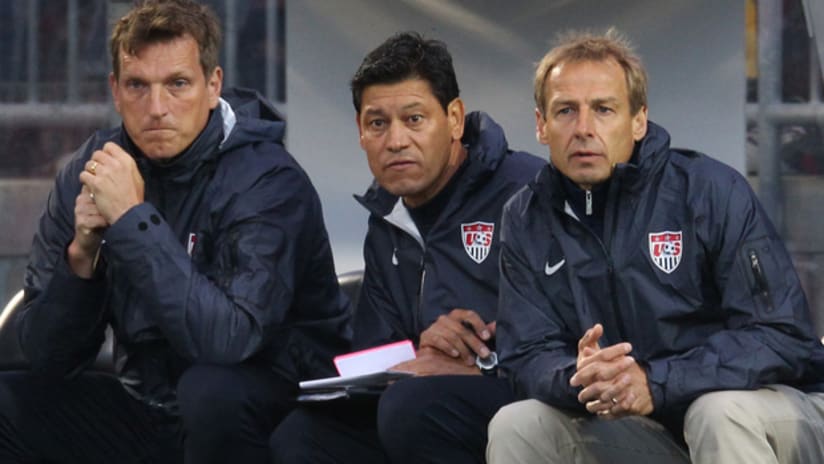It’s been an eventful 10 months on the job for US national team boss Jurgen Klinsmann. Since assuming his post on July 29, 2011, he’s laid out his vision of a program-wide transformation, spoken out on a broad range of issues at all levels of his adopted nation’s soccer culture, brought in a bevy of new players and spearheaded a media and public relations outreach of a magnitude unimaginable to his quiet predecessor Bob Bradley.
But he’s yet to face a single high-stakes, must-win game. He hasn’t had to make a pitch-perfect tactical or lineup selection for such situations, or make a pivotal adjustment in the run of play.
And while Friday’s CONCACAF World Cup qualifying curtain-raiser against tiny Antigua & Barbuda (7 pm ET, ESPN, live chat on MLSsoccer.com) is unlikely to present excessive hardships for Klinsmann and his squad, the challenges ahead are likely to draw the spotlight to the charismatic German’s decision-making, some examples of which have already raised eyebrows.
First of all, what is the Yanks’ best formation? So far we’ve seen 4-3-3, 4-2-3-1, 4-1-4-1, 4-4-2 and more, and none have quite seemed like the perfect fit for the personnel used. After giving the early impression that an FC Barcelona-inspired 4-3-3 was his archetype, Klinsmann clarified that shape was less important than style and mentality, and he’s been fairly clear about the type of soccer he wants the team to play.
He’s picked players he believes can fulfill this goal, and though every top coach on earth will at some point be second-guessed for their squad selections, most of his current roster picks need little defending.
Less understandable are the ways in which some of them have been used.
Many fans were delighted to see Jose Francisco Torres brought out of the international wilderness and handed another chance to lock down a starting midfield spot. But Klinsmann has usually posted the slender Texan on the left wing, a position hardly suited to his skillset and one where he’s been prone to anonymity.
The central “metronome” role Torres might wish to occupy has instead been filled by a range of contenders, most recently Maurice Edu and Jermaine Jones, who are physical specimens, but proven destroyers better suited to deeper, holding roles. One or both may yet craft a reliable chemistry with Michael Bradley, the undoubted US star of the past six months and a guaranteed starter for the foreseeable future.
However, the continued growth in so many facets of Bradley’s game raises the question of whether he needs to push into a more advanced position, or even given free rein to roam where he likes. The US were far more dangerous against Italy and Brazil – the two headline-grabbing opponents of the last six months – when Bradley pressed farther up the pitch, after all.
Each of these decisions has resulting consequences. Is Clint Dempsey the best option on the left, or does he create more danger as a withdrawn striker? Is the US attack at its best when there are two out-and-out strikers, like Jozy Altidore and Herculez Gomez, to play through? How do the pieces not only fit, but fit best?
This is only a brief snippet of the tactical choices facing Klinsmann, who came in for heavy, if not always fair, criticism in this department during his last coaching gig at Bayern Munich. We haven’t even touched on the situation in defense, where the selection of starting center backs looks both crucial and uncertain.
The coach and his staff repeatedly stated that the US’ current stretch of action marked the end of their experimentation period, and was being approached as a “five-game tournament” in terms of planning, logistics and mentality. The unevenness of the team’s last two displays – the 4-1 loss to Brazil and Sunday’s turgid, scoreless draw with Canada – suggests that this mindset didn’t quite take root.
It may be simplistic to point out that with a win, a loss, a draw and a plus-one goal differential, the Yanks would have needed a dose of good fortune to escape the group phase of this theoretical tourney. Yet the margins for error aren’t really that much greater in their six qualifiers over the next five months, to say nothing of the hexagonal round which follows.
Antigua & Barbuda must be swept aside with even more ruthlessness than Scotland were. Guatemala represent one of the more treacherous road trips – and conversely, obdurate visiting teams – in CONCACAF, and Jamaica, while carrying a long winless streak against the US, are athletic enough to trouble anyone in the region on their day.
And if Klinsmann doesn’t get most of his big decisions right, everything will get even more complicated in a hurry.













